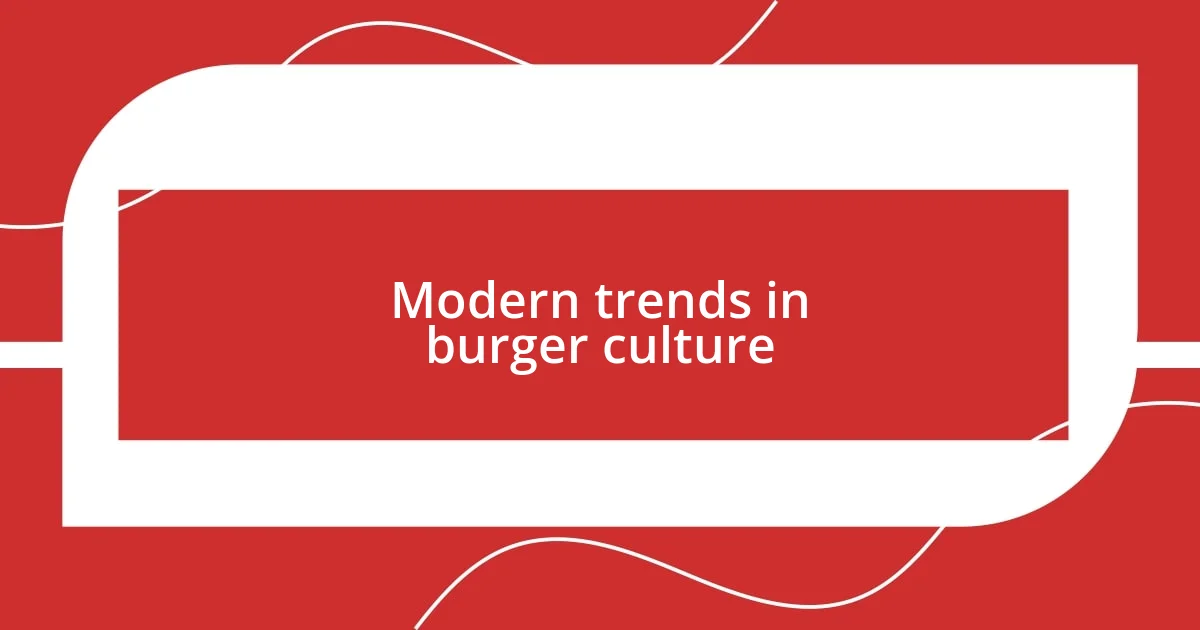Key takeaways:
- The hamburger originated from German immigrants’ “Hamburg steak” and evolved in America, becoming a popular, portable meal by the late 19th century.
- Key milestones in burger history include the introduction of the cheeseburger in the 1920s, the rise of fast-food burgers in the 1950s, and the emergence of gourmet burgers in the 21st century.
- Modern trends in burger culture feature plant-based alternatives, international flavor influences, and burger-themed festivals, reflecting a shift towards sustainability and global culinary fusion.

The origins of the hamburger
The hamburger, as we know it today, has a fascinating origin rooted deeply in European culinary traditions. I often think about how this beloved dish evolved when I hear stories of early German immigrants bringing their “Hamburg steak” to America, a simple yet hearty meal of minced beef that reflects the rich flavors of their homeland. Isn’t it intriguing to consider how a dish born out of necessity has become a global icon?
As time passed through the late 19th century, the transformation began. Imagine young American cooks creatively crafting this German classic into something more approachable, sandwiching it between slices of bread. I remember the first time I saw a roadside diner promoting its “hamburgers” – something about that simple menu item felt like a piece of history nestled between two buns. This clever innovation sparked a revolution in American dining, paving the way for a meal that could be enjoyed on the go.
The question of who truly invented the hamburger often leads to spirited debates among food enthusiasts. Personally, I find joy in imagining the countless variations that have emerged, each telling a story of culture and creativity. Isn’t it fascinating how a simple beef patty can evoke memories and experiences unique to each of us? The hamburger’s history is not just about its origins but its evolution into a canvas for flavors, an invitation to explore and relish.

Key milestones in burger history
Throughout the 20th century, burgers truly began to dominate the American culinary landscape. I can picture diners bustling with energy, where the sizzle of patties on a grill harmonized with lively conversations. This era marked the rise of iconic fast-food chains, with each introducing its twist on the beloved burger, and I often find myself reminiscing about those golden arches, wondering how many families shared moments together over a simple burger meal.
Another milestone to note is the introduction of the cheeseburger in the 1920s. The first time I had a cheeseburger, I felt an instant connection with an entire generation that had experienced this perfect marriage of flavors. The melty cheese melting over the juicy patty adds not just taste but a comforting nostalgia that makes every bite memorable. It’s one of those universal experiences that seemingly everyone can relate to in some form.
Fast forward to the 21st century, the rise of gourmet burgers has taken the dish to new heights. I remember visiting a trendy burger joint where toppings included artisanal bacon, spicy aioli, and locally sourced ingredients – it felt like a culinary adventure on a bun! This transformation from fast-food staple to gourmet experience showcases the versatility of the hamburger, inviting chefs and diners alike to explore new flavors and combinations that haven’t traditionally been associated with burgers.
| Milestone | Year |
|---|---|
| Rise of fast-food burgers | 1950s |
| Introduction of cheeseburger | 1920s |
| Gourmet burgers | 21st century |

Influential figures in burger development
When discussing influential figures in burger development, several names stand out in the lively world of hamburger history. For me, one of the most notable is Louis Lassen, who is often credited with selling the first hamburger in America in 1900 at his small lunch wagon in New Haven, Connecticut. I still remember the thrill I felt when I discovered this story, picturing a bustling wagon filled with hungry customers eager to try something new. His simple concept of placing a beef patty between two slices of bread laid the foundation for the burger industry we adore today.
Another key figure is Walter Anderson, the co-founder of White Castle. I’ve always admired how he revolutionized the fast-food burger by creating the first-ever fast-food chain in 1921. His innovations didn’t just include the slider; they encompassed a streamlined process that ensured consistency and speed. It’s fascinating to me how Walter’s vision made burgers accessible to the masses, turning a humble meal into an indispensable part of American culture.
- Louis Lassen: Often credited with creating the first hamburger in America in 1900.
- Walter Anderson: Co-founder of White Castle; introduced the fast-food burger concept in 1921, setting the standard for consistency.
- James McLamore and David Edgerton: Founders of Burger King, who helped popularize the flame-broiled method in the 1950s, shaping the fast-food landscape.
- Ray Kroc: Instrumental in expanding McDonald’s and promoting a standardized approach to burger making, reaching global culinary influence.
Reflecting on these figures, it strikes me how like a grand tapestry, each person’s contribution is intricately woven into the burger’s rich narrative, influencing what we now consider an American staple. Just like in my own kitchen adventures, where I’ve played with flavors and ingredients, these innovators have crafted a legacy that continues to inspire and tantalize our taste buds.

The rise of gourmet burgers
The gourmet burger trend emerged as chefs began to view the humble patty as a canvas for culinary creativity. I recall one memorable evening when a friend took me to a restaurant that offered a truffle burger topped with wild mushrooms and goat cheese. It was a revelatory experience, highlighting how gourmet burgers invite us to embrace flavors we never thought would pair with a classic burger. What’s fascinating is that this shift created a bridge between comfort food and fine dining.
As gourmet burgers gained popularity, restaurants began experimenting with ingredients and techniques that elevated the experience. I’ve watched food enthusiasts flock to pop-up burger events where the offerings include everything from smoked bacon to spicy jalapeño relish. This trend seems to transform each burger into a work of art, don’t you think? Seeing people share photos of their unique burger creations on social media has made me realize just how much personal expression is now tied up in these meals.
In my own cooking endeavors, I strive to replicate that gourmet touch, and I find myself constantly on the lookout for interesting toppings. There’s something thrilling about tossing unexpected ingredients into the mix. One time, I decided to top my burger with a jalapeño slaw and was blown away by the fresh, zesty kick it added. This experience just reinforces my belief that gourmet burgers are not just about the food; they’re about creating moments and memories around the grill and the table.

Modern trends in burger culture
The modern burger culture has seen a fascinating surge in plant-based alternatives. I remember the first time I tried a burger made from lentils and spices—it was a game-changer! The texture was surprisingly meat-like, and I couldn’t believe how full of flavor it was. This growing trend reflects not just a dietary shift but a deeper desire for sustainability and healthier eating choices. Are we witnessing a culinary evolution that’s rewriting our relationship with food?
Another trend that catches my interest is the exploration of international flavors. It feels as if burgers have become a passport to taste, with influences from different cuisines around the world. I once bit into a kimchi burger, blending savory beef with the tangy crunch of fermented vegetables—it was a delightful surprise. It’s amazing how the love for burgers bridges cultural gaps, allowing us to experience global flavors in one bite. Who knew that a burger could tell such a rich story about culinary fusion?
Furthermore, I’ve noticed the rise of burger-themed festivals that celebrate this iconic dish in vibrant ways. Attending one was a joyous experience, as I mingled with fellow fans, sampling everything from spicy Sriracha-infused patties to sweet, caramelized onion toppings. It made me realize that the burger is more than just a meal; it’s a shared experience that brings people together. Don’t you think there’s something special about bonding over a delicious burger, connecting with others who appreciate the joy it brings?















